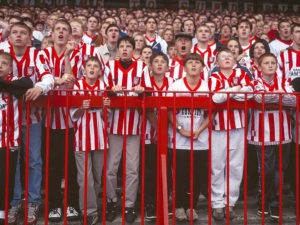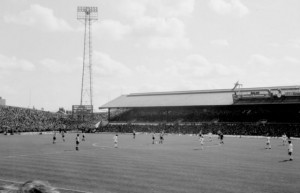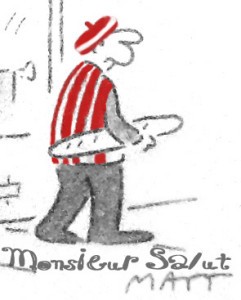
Monsieur Salut writes: my friend and mentor Mike Amos, as good a journalist as the North East has produced, wrote in the Northern Echo a few years back about a Boro player who’d sup pints with the fans before a game, get the bus with them to Ayresome Park and then play his heart out, scoring a few goals in the process.
These days, he’d park his Porsche at the ground early, lower his head – earphones embedded – at any autograph-hunter’s approach and join team mates for a light pasta or salad before going out in hopes of impressing someone in the stands scouting for a bigger club able to pay bigger wages. And plenty of the fans would be making their way back after the match to comfortable homes in suburbia.
Cynical or true? In a survey of fans’ changing perceptions of the game for http://www.ticketgum.com/, attending football emerges as much less a working class pursuit than in the past with good and bad aspects of that evolution. Women are increasingly present, violence around the grounds is on the wane but it’s all become a little more gentrified. But is going to football really a better experience these days, as a big majority of those polled believe? I reproduce a slightly edited version of the article supplied, complete with a few asides of my own.
One health warning: I was involved a little in opinion polls when I worked for The Daily Telegraph and 486 strikes me as a rather small sample. But it’s an interesting talking point, especially for older supporters …
The sports ticket broker, Ticketgum, reports survey findings showing 74 per cent of football fans believe football has changed for the better.
Among other results:
* 62 per cent of British fans are positive about the future of football and its direction [safe to assume not many SAFC supporters can have been polled – Ed?]
* only 19 per cent of football enthusiasts preferred the heydays of football [you can probably count a lot of Salut! Sunderland folk in that 19 per cent – Ed!]
Since the beginning of the Football Association 154 years ago, the landscape of the game has changed remarkably, growing into the most watched sporting league in the world.
Football broadcasts across 212 territories and earns £2.2bn in television rights. The game has evolved and adapted to the needs of its ever-growing audience, particularly with the inception of the Premier League in 1992 and FIFA in 1994.
Ticketgum.com wanted to gain perspective from football fans on how the game has changed over the years. They surveyed 486 football fans aged 35-70 on several factors related to changes in the game.
The findings included the following:
Spectators
Traditionally football was a masculine, no-go area for women. Today there are more women in Britain than ever watching the game, at 7.7m (one third of all UK fans).
* 74 per cent agreed there are more female spectators than ever before [proving that those surveyed are not blind – Ed!]
* 38 per cent believe football spectatorship has become more “middle class” in the past 15 years
* 68 per cent believe football today has wider appeal, reaching a larger demographic of
spectators

Ticketgum.com says it has been argued that the high cost of football tickets and season tickets has attracted a more middle-class audience, with ticket prices going up 12.5 per cent in the past five years.
But football stadiums, once run-down, now have multiple bars, food stands and luxury restaurants where regulars can be granted exclusive membership deals, gaining access to more facilities.
Safety
Ticketgum.com also asked football fans their opinion regarding the safety of spectators.
Football fans were reminded that stadiums are now entirely seated following the Hillsborough disaster where 96 supporters were crushed to death [were they asked their views on the safe standing campaign – Ed?].
* 76 per cent of those surveyed believe during-match violence has declined dramatically; a majority say this is due to better policing strategies and heightened security
* 74 per cent believe football has now become safer for spectators in general
* 59 per cent would bring their children to a game [I am not convinced this has ever been an issue in such places as Sunderland – Ed]
Standards and cost
Also, questions were posed about the quality and cost of football. Ticketgum sought to discover whether fans believed the standard reflects the cost to attend and vice versa.
Neymar’s recent transfer to Paris-Saint-Germain cost a world-record fee of £198m, inspiring ample press attention. The competitive nature of football teams wanting the best players has arguably driven up playing standards.
These were the findings:
* 71 per cent believe football has become a more exciting sport
* 90 per cent believe the quality of play has improved in the past 15 years
* 40 per cent believe the game has become too money-orientated but just 31 per cent think spectating
has become too expensive.
Fans quoted
Karen, 58, from East Sussex: “Football has a wider appeal. As a woman, I don’t feel unsafe attending games like I would’ve done when I was younger. The standard of play has improved; football is the most exciting sport of our time right now.
“It has become more expensive to attend, but you’re paying for a quality stadium and play, so I don’t think it puts people off. The game needed to move with the times and the Premier League gave it the boost it needed.”
Nick, 63, from Reading, disagrees: “I’ve been a fan since I was a boy when I used to go to the local ground with my dad. Football was a different sport back then, it wasn’t flashy like it is nowadays, it was your regular working man’s sport.
“I feel like its lost its spirit. Most players you’d see on the field lived locally; you knew them and not from the papers. Today it’s all money, celebrities and private jets.
“Stadiums don’t have the same atmosphere as when we had the terraces. I know they weren’t safe, but they were exciting, there was a thrill in spectating that you don’t get today.”
Adam Taylor, from TicketGum, says:
Football has evolved over the past decade, on and off the pitch. The game has become very commercialised, which has allowed for [the] injection of money into the league, so clubs can make an active effort to improve different aspects on and off the pitch. This has made the wonderful game more accommodating to seniors, women and families through offering discounts of tickets and creating a more welcoming atmosphere for all.”
Monsieur Salut adds:
As ever, over to the Salut! Sunderland jury. At my great age, I am liable to be dismissed as a reactionary. But I get nothing like the pleasure from attending today’s modern stadiums that I did going to Roker Park every other week as a teenager and while the new stadiums are vastly more comfortable in every respect, the vaunted catering facilities broadly remain unimpressive and expensive.
Of course there are more women and that is to be welcomed. Yes, it’s good that hooliganism, while not quite eliminated, is nowhere near the problem it was. But children always attended games in my early experiences, prices have become crazy, television’s ability to make disruptive changes to kickoff days and times is outrageous and the lack of connection between players and fans is to be regretted.
I still love the game and I love being part of the occasion when Sunderland play, home or away. But to say things have changed for the better is stretching a point.
If you’re interested in the modern game and want to learn more about how the better system works online FanDuel. A friend was telling me about how easy it was to get started with fantasy football.

George Taylor (Shoot)….every week reviewing the Boro game……’now despite the scoreline, this wasn’t a boring game!!!!!!!
Oh yes it was , The World at War (either before shoot or just after it) was more unpredictable and exciting than any of the Boro highlights ever were, and we all knew the result of WWII.
They were the days.
Oh I blame George Eastham
Ah, peanuts. As in tanner a bag? Who was that Roker legend again? The name used to trip from my lips
Of course as in tanner a bag. I can’t remember his name either but he had a canny aim.
I’m not sure older or middle aged were targeted. Most people under the age of 40 or so will be comparing the game today with the late 80s, 90s and noughties. Many I think, will have been brought up at a time when footy on TV is omnipresent, rather than a short highlights programme in between cup finals. The whole comparison thing seems a bit flawed when people of differing ages will not be comparing like for like.
Also I assume it was aimed at supporters of Premier League clubs, because not all grounds are all seater, once you drop down a step or two.
I’m going all Ron Manager here! Things I miss about going to football:
1 the smell of pipe smoke on a damp autumn Wednesday at a midweek game under lights.
2 steam rising from the thousands standing on terraces after getting soaked on the way to the ground.
3 those steel 4 wheeled bike things that kept tinned burgers and hot dogs warm.
4 rattles and the Man City woman with the bell.
5 programmes with the Football League Review in the middle.
6 the Football Echo.
7 no TV replays so you could argue about controversial decisions at school/work for days after.
8 boards with letters for the half time scores.
9 peanuts.
10 muddy pitches
I also noted the “all seater” bit, Malcolm, which made me wonder.
You could be right about the younger group (say 35-45 yrs) having a different perspective to oldies like us.
Can’t agree that those steel 4 wheeled bike things kept burgers warm. I think it was how the vendors relieved themselves that did that.
Approx 1 million people attend EFL/Premiership games on any weekend. Approx 48% of the UK population is aged between 35-70. (Relevant data are widely available on the interweb for you to check my figures).
If football attendance mirrors the population at large (and I can’t say it does) then approx 1/1,000 or 0.1% of any week’s eligible attendance was sampled.
If it’s not exactly the same million attending every week (i.e. some people will go one week but not another) then the football-going population is larger than 1 million and the sample correspondingly less than 0.1%.of the footballing population. Which means the percentages quoted in the survey could be well out.
It’s an interesting discussion but one which is not particularly helped by this survey. One might just as well compare the number of people gaining 5 O levels 50 years ago with the number getting 2:1 honours degrees this year and saying from this that we’re all middle class now so football will be as well.
Hey ho… As long as Khazri b*****s off and takes his attitude elsewhere I don’t really care
I suspect that the “survey/poll” was probably limited to those residing in the Home Counties and the more affluent regions such as Bucks and Berks. I would also suggest that mainly middle aged and older persons were targeted. I doubt whether a poll of fans residing north of Liverpool or Manchester (still seen, I suspect, as the “great unwashed” to Southern residents) would have produced the same result.